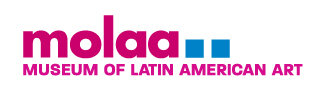Each chapter will feature a conversation between the most remarkable artists from Latin America and Latinx in the U.S. and our MOLAA Chief Curator Gabriela Urtiaga. Together we will focus on a series or specific artwork which requires a close inspection, a deliberate process of contemplation, and exploration; delving into the ideas surrounding the creation of the works, their sources of research and inspiration, in an effort to immerse ourselves in the world of the artists.
Judith F. Baca (United States b. 1946)
One of America’s leading visual artists Dr. Judith F. Baca has been creating public art for four decades. Powerful in size and subject matter, Baca’s murals bring art to where people live and work. In 1974, Baca founded the City of Los Angeles’ first mural program, which produced over 400 murals and employed thousands of local participants, and evolved into an arts organization known as the Social and Public Art Resource Center (SPARC). She continues to serve as SPARC’S artistic director and focuses her creative energy in the UCLA@SPARC Digital/ Mural Lab, employing digital technology to promote social justice and participatory public arts projects. She is an emeritus Professor of the University of California Los Angeles, where she was a senior professor in Studio Art 1980-1996 at the University of California, Irvine and Chicana/o Studies and World Art and Cultures Departments from 1996 until 2018.
Beginning with the awareness that the land has memory, she creates art that is shaped by an interactive relationship of history, people and place. Baca’s public artworks focus on revealing and reconciling diverse peoples’ struggles for their rights and affirm the connections of each community to place. She gives form to monuments that rise up out of neighborhoods. Together with the people who live there, they co-create monumental public art places that become “sites of public memory.” Baca has stood for art in service of equity for all people. Her public arts initiatives reflect the lives and concerns of populations that have been historically disenfranchised, including women, the working poor, youth, the elderly and immigrant communities, throughout Los Angeles and increasingly in national and international venues.
Her most well-known work is The Great Wall of Los Angeles. It is located in San Fernando Valley, the mural spans half a mile and still is a work in progress engaging another generation of youth. The mural-making process exemplified community involvement, employing more than 400 youth and their families from diverse social and economic backgrounds, artists, oral historians and scholars. In 2017, The Great Wall of Los Angeles received national recognition on the National Registry of Historic Places by the US Department of the Interior. In 2012, the Los Angeles Unified School District named a school after her called the Judith F. Baca Arts Academy, located in Watts, her birthplace. She is a recipient of the Guggenheim Fellowship, the United States Artist Rockefeller Fellowship.


